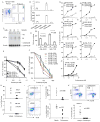Targeting HIF1α eliminates cancer stem cells in hematological malignancies
- PMID: 21474104
- PMCID: PMC3084595
- DOI: 10.1016/j.stem.2011.02.006
Targeting HIF1α eliminates cancer stem cells in hematological malignancies
Abstract
Molecular targeting of cancer stem cells (CSCs) has therapeutic potential for efficient treatment of cancer, although relatively few specific targets have been identified so far. Hypoxia-inducible factor (HIF) was recently shown to regulate the tumorigenic capacity of glioma stem cells under hypoxic conditions. Surprisingly, we found that, under normoxia, HIF1α signaling was selectively activated in the stem cells of mouse lymphoma and human acute myeloid leukemia (AML). HIF1a shRNA and HIF inhibitors abrogated the colony-forming unit (cfu) activity of mouse lymphoma and human AML CSCs. Importantly, the HIF-inhibitor echinomycin efficiently eradicated mouse lymphoma and serially transplantable human AML in xenogeneic models by preferential elimination of CSCs. Hif1α maintains mouse lymphoma CSCs by repressing a negative feedback loop in the Notch pathway. Taken together, our results demonstrate an essential function of Hif1α-Notch interaction in maintaining CSCs and provide an effective approach to target CSCs for therapy of hematological malignancies.
Copyright © 2011 Elsevier Inc. All rights reserved.
Figures






Comment in
-
Blocking HIF1α activity eliminates hematological cancer stem cells.Cell Stem Cell. 2011 Apr 8;8(4):354-6. doi: 10.1016/j.stem.2011.03.006. Cell Stem Cell. 2011. PMID: 21474097
References
-
- Bao S, Wu Q, McLendon RE, Hao Y, Shi Q, Hjelmeland AB, Dewhirst MW, Bigner DD, Rich JN. Glioma stem cells promote radioresistance by preferential activation of the DNA damage response. Nature. 2006;444:756–760. - PubMed
-
- Baumann M, Krause M, Hill R. Exploring the role of cancer stem cells in radioresistance. Nat Rev Cancer. 2008;8:545–554. - PubMed
-
- Beachy PA, Karhadkar SS, Berman DM. Tissue repair and stem cell renewal in carcinogenesis. Nature. 2004;432:324–331. - PubMed
-
- Bonnet D, Dick JE. Human acute myeloid leukemia is organized as a hierarchy that originates from a primitive hematopoietic cell. Nat Med. 1997;3:730–737. - PubMed
Publication types
MeSH terms
Substances
Grants and funding
LinkOut - more resources
Full Text Sources
Other Literature Sources

